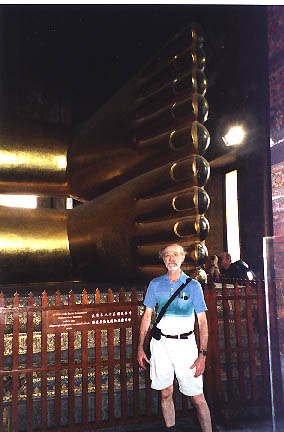 |
| All around
the huge Buddha, there were little collections of
small Buddha statues and other images like the
beautiful emerald collection in the top picture
above, and the fat Buddha directly above. Fat is
not considered healthy in Thailand, so all the
native Buddhas are thin. But, in ancient China,
it was considered healthy to be fat and Chinese
Bhuddas were always fat like the one above. |
| Just to get a sense of scale, on
the left, I am standing in front of the reclining
Buddha's feet, with it's ten toes. |
| On one side of the room
containing the big Buddha, there were rows of
pots. Putting coins in the pots was somehow an
act of worship which would raise one's standing
as a Buddhist. |
|
